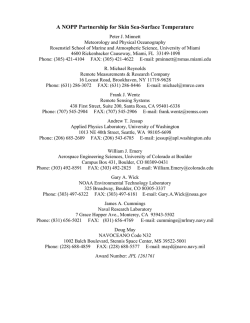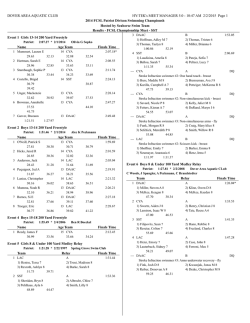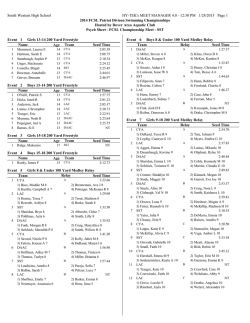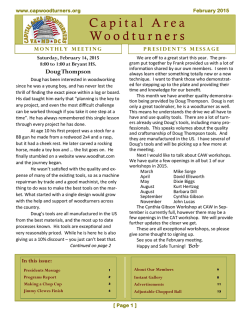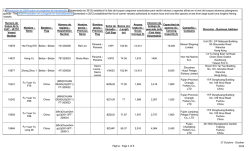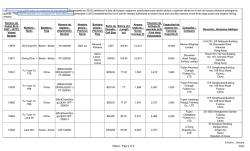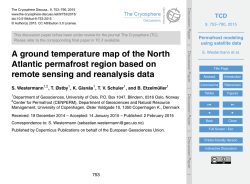
05: A NOPP Partnership for Skin Sea
A NOPP Partnership for Skin Sea-Surface Temperature Peter J. Minnett Meteorology and Physical Oceanography Rosenstiel School of Marine and Atmospheric Science, University of Miami 4600 Rickenbacker Causeway, Miami, FL 33149-1098 Phone: (305) 421-4104 FAX: (305) 421-4622 E-mail: [email protected] R. Michael Reynolds Remote Measurements & Research Company 16 Locust Road, Brookhaven, NY 11719-9628 Phone: (631) 286-3072 FAX: (631) 286-8446 E-mail: [email protected] Frank J. Wentz Remote Sensing Systems 438 First Street, Suite 200, Santa Rosa, CA 95401-6338 Phone: (707) 545-2904 FAX: (707) 545-2906 E-mail: [email protected] Andrew T. Jessup Applied Physics Laboratory, University of Washington 1013 NE 40th Street, Seattle, WA 98105-6698 Phone: (206) 685-2609 FAX: (206) 543-6785 E-mail: [email protected] William J. Emery Aerospace Engineering Sciences, University of Colorado at Boulder Campus Box 431, Boulder, CO 80309-0431 Phone: (303) 492-8591 FAX: (303) 492-2825 E-mail: [email protected] Gary A. Wick NOAA Environmental Technology Laboratory 325 Broadway, Boulder, CO 80305-3337 Phone: (303) 497-6322 FAX: (303) 497-6181 E-mail: [email protected] James A. Cummings Naval Research Laboratory 7 Grace Hopper Ave., Monterey, CA 93943-5502 Phone: (831) 656-5021 FAX: (831) 656-4769 E-mail: [email protected] Doug May NAVOCEANO Code N32 1002 Balch Boulevard, Stennis Space Center, MS 39522-5001 Phone: (228) 688-4859 FAX: (228) 688-5577 E-mail: [email protected] Award Number: JPL 1261761 LONG-TERM GOALS Sea surface temperature (SST) is an important parameter in many operational and research activities, ranging from weather forecasting to climate research. The goals of this project are to demonstrate the use of autonomous infrared radiometers that measure the skin SST to absolute accuracies that are useful for the validation of global SST fields derived from measurements on earth-observation satellites, to use these measurements to determine the accuracies of such remotely-sensed SSTs, and to demonstrate the use of skin SSTs in forecast models. OBJECTIVES As a result of the heat flow between the ocean and overlying atmosphere, the surface of the ocean is nearly always somewhat cooler than the water at a depth of a millimeter or more. The temperature difference across the thermal conductive layer at the sea surface is usually referred to as the skin effect the surface is called the thermal skin effect. During the day, solar heating may cause vertical temperature gradient in the uppermost several meters of the ocean, especially in conditions of low wind speed, which further decouple the bulk “SSTs,” conventionally measured by thermometers at a depth of a meter or so, from the skin SST, which is the temperature that controls the exchange of heat, momentum and gases between the ocean and atmosphere. Furthermore, it is the skin temperature that gives rise to the signal measured by space-borne radiometers. Thus, the uncertainties in the satellitederived SST fields determined by comparisons with sub-surface bulk temperature include a component due to the variability in the temperature gradients in the upper few meters, and across the skin layer. The objectives are to provide accurate skin SSTs using autonomous radiometers, to establish the accuracies of satellite-derived skin SSTs, and to demonstrate the changes, hopefully improvements, in the coupling between ocean and atmosphere in forecast models, and process models that help us understand the physical behavior of the skin layer. The project is broken down into three components: 1. The deployment at sea, in an environment comparable to ships of the Voluntary Observing Ship (VOS) fleet, instruments for measuring the skin and bulk SST, and telemetering these measurements for use in an operational environment in near real time. 2. Using the skin temperature measurements to demonstrate the accuracy of the skin SSTs derived from a variety of satellite-borne radiometers, operating in both the infrared and microwave. 3. Demonstrating the use of the skin SST in an operational program as a pre-cursor to wide-spread use of the skin SSTs. These are divided amongst the various partners in the project according to skills and existing facilities. Many of the activities leverage funds from other agencies to achieve these goals APPROACH AND WORK PLAN The approach has been to adopt the Infrared Scanning Autonomous Radiometer (ISAR; see http://www.gim.bnl.gov/instruments/isar/) and the Calibrated InfraRed In situ Measurement System (CIRIMS; Jessup et al., 2002) as the autonomous radiometers for use in this project. The ISAR was developed at the Southampton Oceanography Centre (SOC) in the UK and CIRIMS at the Applied physics Laboratory at the University of Washington, Seattle. The absolute accuracy of the two sets of radiometers is established by at-sea comparisons with the at-sea measurements of the MarineAtmospheric Emitted Radiance Interferometer (M-AERI; Minnett et al., 2001). The skin SST measurements are used to determine the accuracy of the SSTs derived from the infrared bands of MODerate-resolution Imaging Spectrometer (MODIS; Esaias et al., 1998) on the NASA EOS Terra and Aqua Satellites, and of the microwave measurements of the TRMM (Tropical Rainfall Measuring Mission) Microwave Radiometer (TMI), and the Advanced Microwave Scanning Radiometer for EOS (AMSR-E) on Aqua. Studies using the skin SST measurements, together with theoretical models, are undertaken to determine improved parameterizations of the skin effect for inclusion in models, and the consequences of using skin SST, as opposed to bulk SST, in process models focused on differences between skin and bulk SSTs are being used. The key individuals leading the various components of the project are given in Table 1. Table 1: Major partners and their roles in this project. Partner Roles and Tasks P. J. Minnett University of Miami R. M. Reynolds Remote Measurements & Research Co. A. T. Jessup APL - University of Washington F. Wentz Remote Sensing Systems W. J. Emery University of Colorado G. A. Wick NOAA-ETL J. Cummings NRL Monterey D. May NAVOCEANO Project lead, M-AERI deployments, absolute calibrations of sensors, AVHRR and MODIS analyses Instrument integration, at-sea deployments Instrument calibration, at-sea deployments Microwave SSTs Bulk-skin models, regression skin SST analysis Near-surface temperature models, GOES SST analysis Application of skin SST to atmospheric forecast models Operational applications There have been two changes in the structure of the partnership in the past year. Following a change in the upper management in the SeaKeepers organization, they have withdrawn from the partnership; there is no budget consequence to this development. Dr E. Kearns has taken leave of absence from the University of Miami to undertake full-time research for the National Parks Service; his role within the partnership has been taken over by Dr S. Browdy of OMS Tech Inc, who is supported through a contract to RSMAS. WORK COMPLETED The first ISAR (ISAR-01) was deployed on an NYK ship, the car-transporter Jingu Maru, on July 9, 2005, in Newark N.J. (Figure 1). The Jingu Maru sails between northern European ports and those on the US Eastern Seaboard on a regular basis. The ISAR data are transmitted via Inmarsat-C on an hourly basis to Miami and distributed to the interested partners by email. Following quality control, the times and locations of the measurements (determined by a GPS receiver integral to the ISAR) are used to determine the appropriate MODIS data granules for subsequent analysis. ISAR skin SST values are entered into the MODIS Match-up Data Base. Figure 1. The NYK Ship Jungu Maru (left) and the location of the ISAR above the bridge (right). Figure 2. Skin SST measured by the ISAR on the Jungu Maru on the first transAtlantic crossing after installation. The gaps result from the instrument entering a protective mode during rain events. The second NOPP ISAR (ISAR-04) was completed in August 2005 and was first deployed on a cruise of the Russian icebreaker Kapitan Dranitsyn from northern Norway to the Laptev Sea and back. This deployment revealed several problems with the ISAR configuration in its vulnerability to icing and the increased power requirements when running at sub-zero temperatures. Although this cruise was in the Arctic Ocean, the weather conditions were not exceptionally severe and are likely to be experienced by VOS ships plying the North Atlantic and Pacific Oceans in wintertime. This experience has indicated some necessary improvements that will be made to render the instruments more robust for year-round deployments in the full range of marine conditions. Two CIRIMS have been deployed continuously on the NOAA R/V Ronald H. Brown and the R/V Thomas G. Thompson. Both ships also have through-the-hull thermometers at depths of 2 and 3m. Data are transmitted back to land on a daily basis. These data, as well as all data collected under prior funding, are available on the CIRIMS web site (http://cirims.apl.washington.edu/). A comparison of TMI and AMSR-E SSTs and in situ data has been conducted to give a base-line accuracy of the microwave satellite SST retrievals (Gentemann et al., 2004). The primary source of validation data used in this study are in-situ measurements collected from the existing network of fixed buoys, drifting buoys, and ship measurements available via the Global Telecommunication System. These data are compiled by the US Navy Fleet Numerical Meteorology and Oceanography Center, quality controlled, and available in near real-time from the USGODAE server in Monterey. A secondary validation data set consisting of additional delayed-mode, quality-controlled, calibrated, fixed buoy SSTs from the US National Data Buoy Center, the Tropical Atmosphere Ocean TRITON, and the PIRATA arrays, was compiled and further quality controlled by Remote Sensing Systems. At the University of Colorado, the CIRIMS and M-AERI data were used in conjunction with infrared satellite imagery to derive a new algorithm for satellite skin SSTs. It is apparent that this brings improvements in accuracy relative to the regression algorithms calibrated against buoy measurements such as the US Naval Oceanographic Office (NAVO) operational SST product, the non-linear SST (NLSST; May et al., 1998). At NRL Monterey, atmospheric boundary layer single column experiments are being run with bulk SST to test the predictions of the skin SST by verifying them against the observed CIRIMS cruise skin SST values. These experiments will be used to improve the boundary layer formulation and parameterization in the COAMPS model. RESULTS Figure 3. Comparison between Terra MODIS SSTs and the ISAR skin temperatures measured from the Jingu Maru on the track shown in Figure 2. The initial results of the first entirely autonomous deployment of an ISAR on a transoceanic section are shown in Figure 2. The comparison with the SSTs derived form measurements of the MODIS on Terra is given in Figure 3. The bias is larger than expected and presumably results form the limited range of atmospheric conditions experienced on this single section. IMPACT AND APPLICATIONS National Security Improved accuracy of remotely sensed oceanographic variables, especially in the coastal regions, and the improved model predictions that will result, will improve National Security. Quality of Life Increased population density the coastal margins of the USA renders more people susceptible to the dangers and disruptions of severe storms. Improved accuracy of remotely sensed oceanographic variables and the improved model predictions that will result, will improve the quality of life of coastal inhabitants. Science Education and Communication Students and post-doctoral scholars at the several universities are involved in this project. New, twoway data transmission and instrument control protocols are being developed. TRANSITIONS There are no transitions to report. These will take place later in the project. RELATED PROJECTS The objectives and activities are related to those of the NOPP-funded project “Multi-sensor Improved Sea Surface Temperature for GODAE.” (PIs Gentemann and Wick). The at-sea measurement program benefits from support from NASA: “Sea Surface Temperature from MODIS” (PIs Minnett and Brown); “Trans-Oceanic Measurements for EOS Aqua Validation” (PI Minnett). The modeling components are connected to Activities supported by the US Navy. This research benefits from connections to several European projects, particularly those focused on the validation of the Advanced Along-Track Scanning Radiometer on the ESA satellite Envisat. REFERENCES Esaias, W. E., M. R. Abbott, I. Barton, O. B. Brown, J. W. Campbell, K. L. Carder, D. K. Clark, R. H. Evans, F. E. Hoge, H. R. Gordon, W. M. Balch, R.Letelier, and P. J. Minnett., 1998: An Overview of MODIS Capabilities for Ocean Science Observations. IEEE Transactions on Geoscience and Remote Sensing, 36, 1250-1265. Gentemann, C. L., F. J. Wentz, C. A. Mears, and D. K. Smith, 2004: In situ validation of Tropical Rainfall Measuring Mission microwave sea surface temperatures. Journal of Geophysical Research, 109. C04021. Jessup, A. T., R. A. Fogelberg, and P. J. Minnett, 2002: Autonomous shipboard radiometer system for in situ validation of satellite SST. Earth Observing Systems VII Conference, Int. Symp. Optical Sci. and Tech, Seattle, SPIE. May, D. A., M. M. Parmeter, D. S. Olszewski, and B. D. Mckenzie, 1998: Operational processing of satellite sea surface temperature retrievals at the Naval Oceanographic Office. Bulletin of the American Meteorological Society, 79, 397-407. Minnett, P. J., R. O. Knuteson, F. A. Best, B. J. Osborne, J. A. Hanafin, and O. B. Brown, 2001: The Marine-Atmospheric Emitted Radiance Interferometer (M-AERI), a high-accuracy, sea-going infrared spectroradiometer. Journal of Atmospheric and Oceanic Technology, 18, 994-1013.
© Copyright 2025
